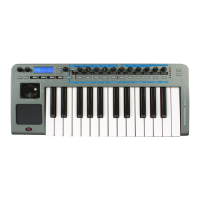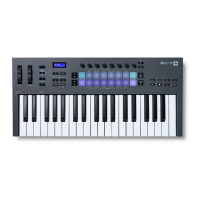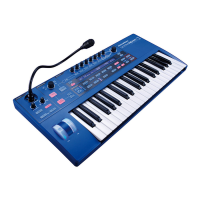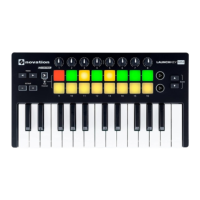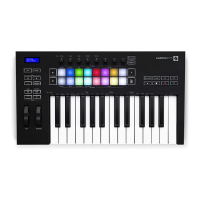Preglide Semitones (Menu Page 4 ‘OSC Preglide’)
A Preglide is applied to the pitch of the Oscillators starting at a pitch
determined by the Preglide amount in semitones. Gliding up from a
pitch occurs when the display indicates between -12 to -1, and gliding
down from a pitch occurs when the display indicates between 1 to 12.
At a setting of 0, no preglide is applied.
The time it takes to complete the Glide is determined by the PORTA-
MENTO knob on the front panel. The Preglide is triggered with every
note received.
Portamento Mode (Menu Page 5 ‘OSC Porta Mode’)
Determines the type of curve applied when PORTAMENTO is used.
Two types of curve are available, Exponential and Linear. Linear
Portamento sweeps through note intervals at a constant rate. When
Exponential Portamento is used, the rate of sweep decreases through-
out the note sweep’s duration.
Start Phase (Menu Page 6 ‘OSC Start Phase’)
When synthesizing percussive or plucked type sounds, there is a lot of
detailed waveform information at the beginning of the sound. It is often
useful to have the Oscillator wave start in exactly the same place every
time a key is pressed.
The start phase option allows the precise starting point of the Oscillator
wave to be determined. At a setting of 0, the wave will start at zero
Degrees. Each increment on the display shifts the start point of the
wave approximately 3 degrees. The wave will start at a random phase
when set to OFF.
FM Synthesis
The next three menu options allow sounds based on FM (Frequency
Modulation) synthesis to be created. Before looking at the operations of
these controls, a little explanation of FM synthesis follows.
Earlier in this manual, the basics of subtractive synthesis were intro-
duced. Terms such as harmonics, timbre, waveforms and oscillators
became familiar.
FM Synthesis is the technique of using one waveform to Frequency
Modulate - FM- another to produce a resultant more harmonically com-
plex waveform.
The following diagram illustrates that the higher the modulation
between the Modulating wave and the Carrier wave, the more the
waveform changes.
In the illustration, the Oscillators are producing Sine waves. It is the
change in harmonics over time that makes a sound interesting to our
ears.
In FM synthesis, an envelope generator is inserted between the modu-
lator and carrier waveforms so that there is control over of how much of
the frequency modulation is taking place with respect to time. Adding
this envelope constructs the basic FM building block as shown in the
nex illustration.
It can be seen that the output waveform begins by being identical to the
carrier, but becomes more complex (harmonics are added) as the
amount of FM modulation increases via the envelope. It then returns to
a simple wave again as the envelope decays.
The timbre of the Waveform is changing with time. This is the opposite
of subtractive synthesis where a low pass Filter is used to remove har-
monics.
To complete a simple synthesizer, a further envelope is added to control
the output volume.
The complete FM building block is illustrated below.
OSC 2 is able to FM (Frequency Modulate) OSC 3 via the dedicated
FM envelope. It is important that it is realized that this Envelope is used
only for FM purposes.
The diagram below shows in block diagram format how the KS Synth
can produce FM sounds.
The easiest way to be totally familiar with FM is to take one of the fac-
tory preset FM sounds, for example Synth Patch 189, an electric piano /
bell sound and to experiment by modifying the various FM settings.
THE KS SYNTHESIZER
The Oscillator Menu
• 45 •

